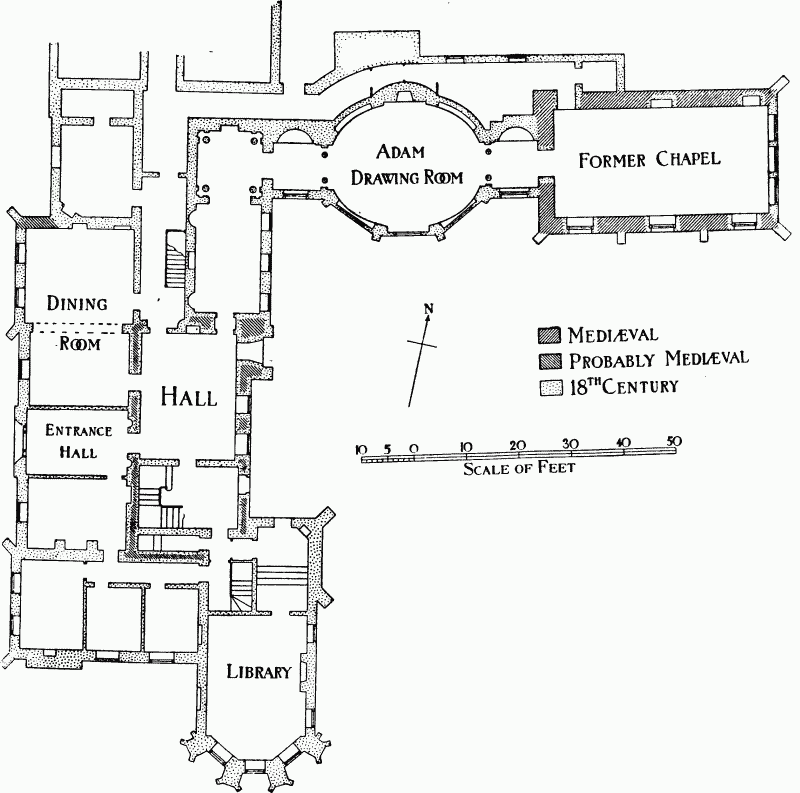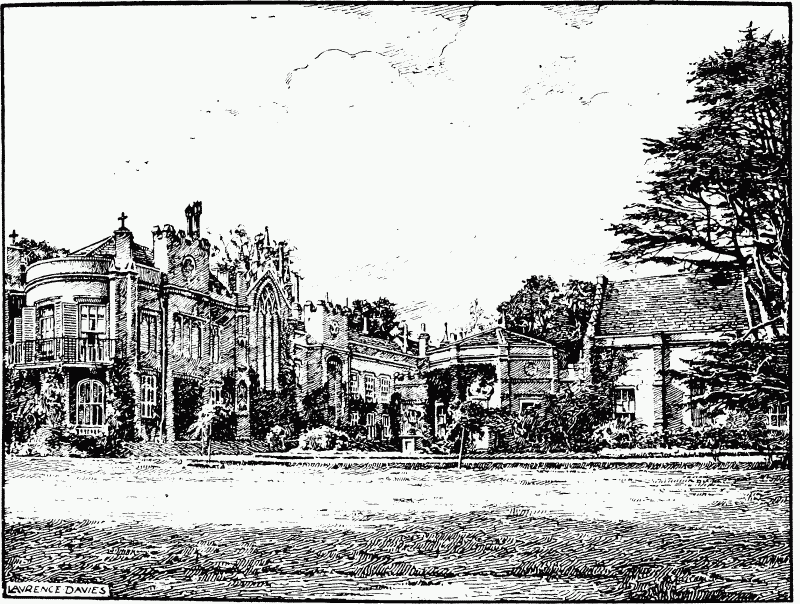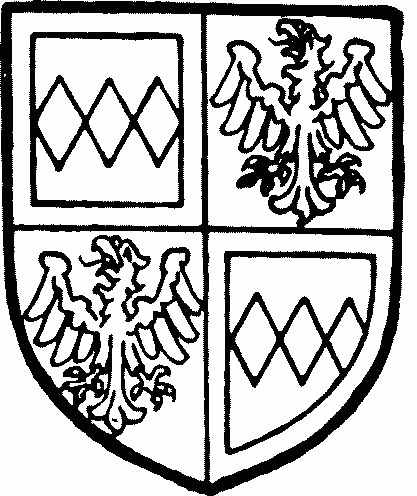A History of the County of Berkshire: Volume 4. Originally published by Victoria County History, London, 1924.
This free content was digitised by double rekeying. All rights reserved.
'Parishes: Sandleford', in A History of the County of Berkshire: Volume 4, (London, 1924) pp. 84-87. British History Online https://www.british-history.ac.uk/vch/berks/vol4/pp84-87 [accessed 23 April 2024]
In this section
SANDLEFORD
The little parish of Sandleford lies south of the borough of Newbury, on the north slope of the valley of the Enborne stream, which forms its southern boundary. It contains 520 acres, of which more than half are pasture, woodland and arable being nearly equally divided. (fn. 1)
The mansion known as Sandleford Priory stands in a well-wooded park about 2 miles to the south of Newbury. The only portion of the building which is certainly a relic of the priory buildings is a large room, almost wholly detached, standing at the east end of the house; it is about 41 ft. by 20 ft., lies east and west, and is said to have been the chapel. There is no external evidence of its age except perhaps the flint walling on the north side. The plaster ceiling is flat, but above it is a gabled roof in which are the moulded ribs of a pointed cradle ceiling dating from about 1400–20, and in the west wall above the present ceiling are the jambs of a contemporary window, probably of three lights. Its present pointed arch is obviously a modern substitute. The east wall is modern and with the south wall is cemented outside. The north side of the roof is tiled and the south slated.
The chapel is connected with the main building by the drawing-room, a fine oval room of the Adam type, between two small square ante-rooms. The late 18th-century main building was designed by Wyatt, in a Gothic style, and is wholly cemented externally. It is difficult to trace any remains of the priory buildings in the present plan, but a thick wall here and there and the presence of a certain amount of flint work in the cellar and in the north return wall of the west front suggest an early origin.
The grounds are well timbered and contain some fine rhododendron beds. A cedar by the chapel measures 16 ft. 3 in. in girth.
Manor
The greater part of the parish was included in the manor of 'Ulvritone' at the time of the Domesday Survey, but was granted to the Prior and canons of Sandleford by Geoffrey fourth Count of Perch and Maud his wife when they founded the priory between 1193 and 1202. (fn. 2) The remainder consists of contiguous lands, originally in the manor of Greenham, granted to the prior and canons in 1349 by John de Estbury and others. (fn. 3)
Before the foundation of the priory an anchoress had settled on the site, for in 1179–80 Godfrey and Richard of Newbury, who rendered account of £49 for the farm of Newbury, paid 4s. 4d. to the anchoress (inclusa) of 'Sandraford.' (fn. 4) The house was dedicated in honour of St. John Baptist. (fn. 5) The information that can be gathered concerning it is meagre and has already been summarized. (fn. 6)
It appears, however, that Maud de Clare, Countess of Gloucester and Hertford, learning that the house was occupied by three Augustinian canons without abbot or prior, conceived the project of founding a convent for forty inclosed nuns under the rule of St. Augustine and, in a place apart, for ten priests of the order of Fontevraud, at Sandleford in the diocese of Salisbury. She was prepared to increase the endowment from £100 to £200, directing that one of the priests should act as prior with the assent of the abbots (sic) and nuns. A papal mandate of 1274 directed the fulfilment of her intentions. (fn. 7)

Plan Of Sandleford Priory
In the 15th century Sandleford Priory declined. Simon Dam, a prior of evil life, by reckless waste and improvident leases, brought it near ruin, and his successors were unable to retrieve the fortunes of the house. In 1478 it was deserted by the monks and all the Berkshire estate lately belonging to the Prior and convent of Sandleford came into the hands of the Bishop of Salisbury as an escheat on the death of the last prior. (fn. 8) The bishop handed them over to his nephew Richard Beauchamp, son and heir of Richard Beauchamp, kt., Lord St. Amand, and he surrendered them the same year to the Dean and Canons of Windsor. (fn. 9)
The dean and canons seem to have let the house and land as a farm, and the chapel fell out of repair. Little is known of the estate or the lessees for two hundred years except that in the reign of James I a dispute as to the tithes came before the King's Bench in 1615, when it was decided that Sandleford was not within the parish of Newbury, but was a parish by itself. (fn. 10)
The priory seems to have been leased during the latter part of the 17th century to John Kingsmill, who is described as of Sandleford when he took the oath of supremacy in 1685, and in 1706 Mr. Kingsmill of Sandleford was summoned with other justices to quell the riot in Newbury. In 1710 the estate was leased to Henry Kingsmill, who died between 9 July 1715 and 4 June 1717, when his executors assigned the lease to William Cradock of Gainsford, Durham. (fn. 11)

Sandleford Priory From The South
Mr. Cradock married in 1715 Mary daughter of Gilbert Sheldon of St. Andrew's, Holborn, and died in 1736, having in 1729 disposed of the lease to Thomas Blake, late of Croydon, who in 1730 assigned it to Edward Montagu, a grandson of the first Earl of Sandwich. He married in 1742 Elizabeth daughter of Matthew Robinson of West Layton, Yorkshire, who as the famous 'blue stocking' is better known than her husband.
Edward Montagu died in May 1775, aged eightythree, and after his death his widow made considerable alterations to the house, adding a new drawing room and converting the ruined chapel into an 'eating room.' She died 25 August 1800 at the age of eighty, when the lease passed to her nephew Matthew Robinson, who had taken the name of Montagu.

Montagu. Argent a fesse indented of three points and a border sable quartered with Or an eagle vert.
This Matthew Montagu, who was born 23 November 1762, and entered Parliament as member for Bossiney in 1786, was elected for Tregony in 1790 and for St. Germans in 1806 and 1807. He married in July 1785 Elizabeth daughter of Francis Charlton, who died in 1817, and in 1829 he succeeded his brother in the barony and became fourth Lord Rokeby. He died 1 September 1831, aged sixty-eight.
His eldest son Edward fifth Lord Rokeby succeeded to Sandleford and died unmarried in 1847, having disposed of the lease of the priory in 1835 to William Pollet Brown Chatteris.
Mr. Chatteris had married two years earlier Anne eldest daughter of Alexander Arbuthnot, Bishop of Killaloe. She died in 1847, and a few years later he took as his second wife Emily Georgina daughter of Sir Thomas Hardy. In 1871 he enfranchised the estate by paying a considerable sum to the Dean and Canons of Windsor and died in January 1889, when under his will the estate passed to his nephew Alpin Macgregor, youngest son of Sir John Atholl Macgregor, bart., and Mary Charlotte his wife, sister of the second Mrs. Chatteris.
Mr. Alpin Macgregor never lived at Sandleford, but let the place to various tenants. He died in November 1899, bequeathing most of the estate to his brothers and sister, and Sandleford Lodge to his niece Miss Agatha Thynne, now Lady Hindlip. (fn. 12) The present tenant is Mrs. Myers, who has held it since 1898.
